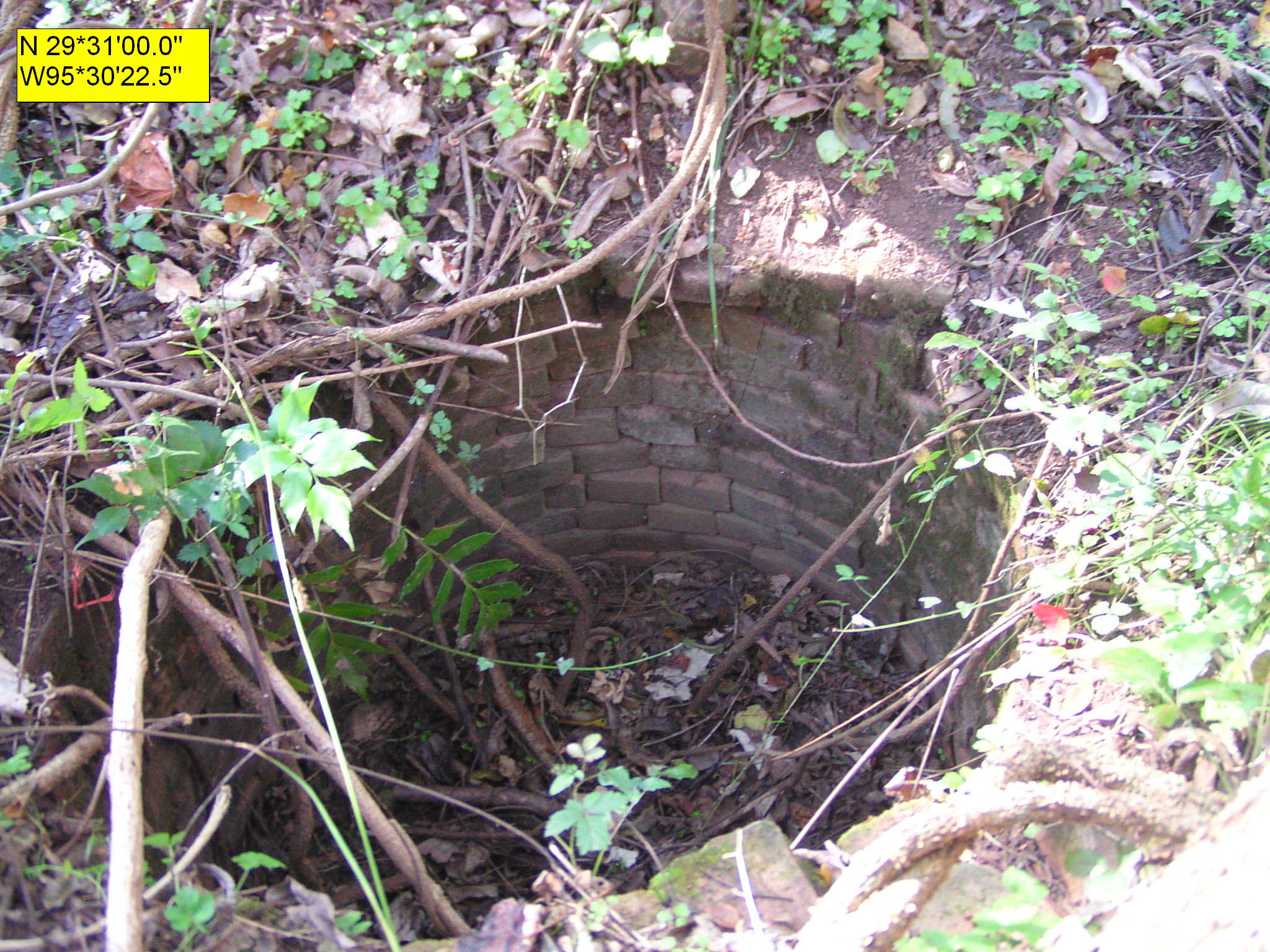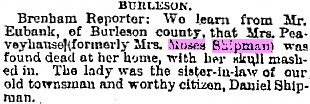Moses Shipman
Moses Shipman was born September 22, 1774 in Kentucky. He married Mary Robinson of South Carolina in 1798, and they became parents of ten children, the first, a son born in North Carolina in 1801, dying in infancy. Another son was born in 1803 in Tennessee, another son in 1805 in North Carolina, along with a girl in 1808. Moses shipman then moved to South Carolina where a girl was born in 1813, then to Tennessee, where a son was born in 1816. He then moved to Missouri where
a daughter was born in 1819. [This daughter is Elizabeth who marries John V. Morton and lived at Duke] He then moved to Arkansas where Lucetta was born in 1821. They left Cole county Missouri, on October 23, 1821, to come to Austin's Colony. They crossed the Arkansas River on Christmas day 1821, about 75 miles from Fort Smith where they were told that they could not cross
the mountains
with wagons. So selling what they could, and giving the rest away what they could not pack on mules or carry,
they made it over the mountains and crossed over into Texas a little below Jonesborough. They stayed there until March 1823, when a son Daniel Shipman and George Nidiver left to scout the Brazos country. Upon reaching Robinson's ferry on the Brazos, they crossed into Washington county and found some land which they planted in corn, then hired three men to look after it until they could go back for the rest of the party. A crop was made here in 1823 about two miles south of Independence, and in 1825 they moved
onto a labor of land near San Felipe and built some log houses. Joseph Bays, the old Baptist preacher, was said to have preached a sermon there in the Shipman home. Later they moved to Oyster Creek in Fort Bend County where they were neighbors and friends of the Perry, Fitzgerald, Fenn and Williams families. John M. Shipman was in the Mier expedition in which he lost his life. During the runaway
scrape in April of 1836, Santa Anna burned the settlers homes, camped at Stafford Point and
there he destroyed Moses Shipman's property. After the runaway scrape Eli and Sarah Fenn, whose home was burned by the Mexicans on the Morton league, moved temporally to the Moses Shipman place. Moses died sometime after signing the petetion to form Fort Bend County in 1837. Mary lived on her league until her death. James R. Shipman was living on the league in 1873.
Moses son, Daniel Shipman, served in Capt. Francis W. Johnson's company in the Anahuac Disturbances of 1832 [as did David Fitzgerald and in Capt. John Byrd's company at the siege of Bexar. He was with Lt. Thomas H. Borden, the company's temporary commander, at the storming
of the city in December 1835, and is said to have been at the side of Benjamin
R. Milam when Milam was shot. On August 2, 1836,
Shipman and his father enlisted in Byrd's four-month volunteers; Shipman served
until the company was disbanded on January 18, 1837. In February 1838 Shipman
received half a league and a labor in Harris County as a head of household and
an army veteran. By 1840 he owned 2,214 acres of land in Bexar County, an equal
amount in Brazoria County, and 288 acres in Harris County. On February 24, 1844,
he was elected justice of the peace of Fort Bend County. In 1867 he was a
resident of Washington County.
The Duke cemetery is a short distance south of
the Moses Shipman league. Mary Shipman should be buried beside her husband
|

This photo was taken in 2010.
This is an early well for water lined with home made bicks. In the late 1800's cisterns were built to catch and hold water that was drained from a dwelling roof. The cisterns were built like a bottle with a narrow neck for an opening above the ground level. Cisterns were lined with home made brick and were sealed with mortor on the sides and bottom. Rain water from a cistern was without the minerals found in ground water produced from a well.
|
The photo on the left was taken at the exact spot of the Moses Shipman home. Judge Senior reconstucted the Shipman home to a two story dwelling. Sometime after Judge Senior's death vandals burned the vacant structure.
The original Moses Shipman home was constructed sometime in early 1820. In 1836, after Mexican General, Santa Anna, destroyed the Fitzgerald dwelling across the Brazos river from old Fort Bend, during the Runaway Scrape, Fitzgeral's daughter, Sarah Fenn, and her family lived with Moses Shipman until they could relocate.
In 1845, Rebecca Williams, future wife of
John R. Fenn, came toTexas with her family.
She was ten years old. Their
first year was spent in the old homestead of Moses Shipman. The logs and boards of the house were all
made by hand and joined together with wooden pins as there were no iron bolts
or nails available. They used water from
creeks and ponds. The home of ‘Judge Senior’ would later be at this
location.
Daniel Williams and his wife Ann Fitz Randolph Ayers Williams were the parents of Rebecca Williams Fenn and Johnny Williams. Daniel Williams and his wife Ann Fitz Randolph Ayers Williams are buried at the Duke Cemetery. Judge Senior and Johnny Williams lived here together for years.
.
|
The Handbook of Texas says;
SHIPMAN, MOSES (?-1836?). Moses Shipman, a native of North Carolina
and an Old Three Hundred colonist, married
Mary Robinson of South Carolina on January 19, 1798; they had ten children. The
family appears to have lived in North Carolina, South Carolina, Tennessee, and
Arkansas. By 1819 they had moved west to Missouri, where they remained until
October 1821, when they started for Texas; they crossed the Red River near
Jonesboro on March 9, 1822. After a favorable report by Moses's son Daniel
Shipman on the Austin colony, the family moved
to the Brazos River area in March 1823 and located in the fork of Mill Creek and
the Brazos River near San Felipe. On July 19, 1824, Shipman received title to a
sitio of land that later became part of Fort
Bend County and a labor of land now in Austin County. In 1825 the family moved
from the Austin County location to a league on Oyster Creek twenty miles below
the site of present Richmond in Fort Bend County. The census of March 1826
listed a household consisting of Shipman, his wife Mary, and their eight
children. In April 1834 Shipman attended court under live oak trees at the home
of Dr. Pleasant W. Rose. In February 1836 he was president of the election at
John Owens's home to choose delegates to the Convention of 1836. As the Mexican army of Antonio López de Santa
Anna approached the Fort Bend area Shipman and
his family joined their neighbors in the Runaway Scrape. The family had reached Lynchburg when the news of
the battle of San Jacinto halted their exodus.
On their return home the Shipman family camped one night on the field at San
Jacinto, surrounded by hundreds of unburied Mexican corpses. At home the
Shipmans found destroyed fences and slaughtered cattle and began to rebuild.
Sources disagree whether Shipman died late in 1836 or in January 1838.
BIBLIOGRAPHY: Robert Allen, "Among Austin's Original Three Hundred," Voice
of the Mexican Border, January 1934. Lester G. Bugbee, "The Old Three
Hundred: A List of Settlers in Austin's First Colony," Quarterly of the Texas
State Historical Association 1 (October 1897). "Reminiscences of Mrs. Dilue
Harris," Quarterly of the Texas State Historical Association 4, 7
(October 1900, January 1901, January 1904). Daniel Shipman, Frontier Life: 58
Years in Texas (1879). Andrew Jackson Sowell, History of Fort Bend
County (Houston: Coyle, 1904; rpt, Richmond, Texas: Fort Bend County
Historical Museum, 1974). Clarence Wharton, Wharton's History of Fort Bend
County (San Antonio: Naylor, 1939).
The following, adapted from the Chicago Manual of Style, 15th
edition, is the preferred citation for this article.
- GALVESTON DAILY NEWS MAY 31,1887
-
-

-
-
-
-
-
-
- GALVESTON DAILY NEWS JULY 6, 1880


